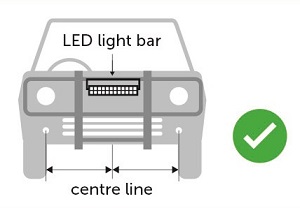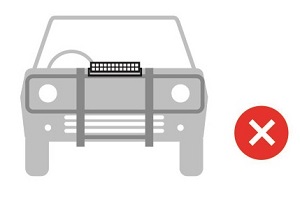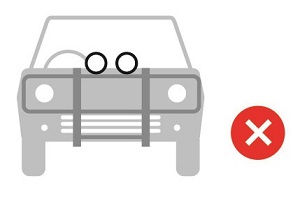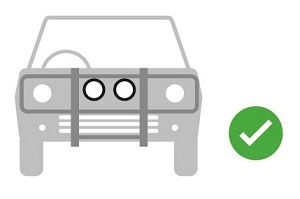Fog lights & additional headlights (driving lights)
Using your vehicle lights incorrectly can make it difficult for other drivers to see. Incorrect use of fog or additional headlights (driving lights) can result in a fine and loss of points from your licence.
Using fog lights
Front fog lights are designed to better illuminate the road in fog, snowfall, rainstorms or dust clouds. They can be recognised by the low, narrow vertical pattern (and wide lateral spread) of light emitted.
Road Rule 217 states that drivers must not use front or rear fog lights unless driving in fog or other hazardous weather conditions that cause reduced visibility. They must be switched on separate from the main beam (high beam) and dipped beam (passing) headlights.
Fog lights should only be used in hazardous weather conditions. Drivers should familiarise themselves with the dashboard warning symbols so that they do not inadvertently switch these lights on.
Using additional headlights (including LED light bars)
Also known as driving lights, additional headlights are used as a supplement to the vehicle's existing headlights and are designed to better illuminate the road over a long distance; as for an example, in country areas.
LED light bars are also considered additional headlights and may be fitted to the front of vehicles provided that they are fitted according to certain conditions.
Additional headlights are considered to be high beam headlights. They must, therefore, follow the same conditions of use as high beam headlights:
- drivers must not use the high beam headlights when driving:
- less than 200 metres behind a vehicle travelling in the same direction or,
- less than 200 metres from an oncoming vehicle
- lights must not be used in a way that they can dazzle other road users (this includes other motor vehicles drivers, bike riders and pedestrians).
Additional headlights, including LED light bars, must also comply with the following conditions:
- the lamps must only be able to be switched on when the high beam headlights are in use, and must automatically turn off when the high beam headlights are turned off
- a maximum of four additional headlights (including LED light bars) may be fitted to a vehicle in addition to the vehicle’s main beam headlights
- the lamps must always face forward and show white light only
- if fitted as pairs, they must be symmetrically positioned in relation to the vehicle's centre line (see fig. 1)


Fig. 1
- if not fitted as pairs, such as in the case of a single LED light bar, it must be positioned at the centre of the vehicle, symmetrical to its centre line
- the lamps must be installed in a way that the light produced does not cause discomfort or glare to the driver either directly or by reflection
- the lamps must not obstruct the driver’s view of the road
- the lamps must not be mounted on a bull bar in a way that they protrude above the top or front of the bull bar (see fig. 2).




Fig. 2
Daytime running lights
The increased presence of daytime running lights on modern vehicles has caused some confusion within the community. Due to their outwardly similar appearance some drivers are confusing the functions of daytime running lights, driving lights and fog lights.
The purpose of daytime running lights is to increase the visibility of a vehicle to other road users in daylight conditions. The pattern of light produced by a daytime running light is designed to make the vehicle more conspicuous to all road users around the vehicle without causing unnecessary glare or discomfort.
Conversely, driving lights and fog lights are designed to increase visibility for the driver of the vehicle during night and hazardous conditions respectively, but may cause glare and discomfort for other road users. Fog lights and driving lights must not be used as a substitute for daytime running lights.
The results of European studies have shown that daytime running lights assist road users to easily recognise and identify vehicles. As a result, the European Commission mandated the addition of daytime running lights to new vehicles from 2011. A number of European manufacturers have brought these vehicles to Australia.
However, the merits of daytime running lights are yet to be demonstrated in Australian conditions. As Australia has not followed Europe in mandating daytime running lights, not all new vehicles are equipped with daytime running lights.
Daytime running lights are designed to switch on automatically when the engine starts and switch off automatically when fog lights or headlights are switched on. Some vehicles have the ability to adjust daytime running lights to become part of the headlight system. They produce minimal glare in comparison to driving lights and fog lights when used correctly.
The most commonly seen daytime running lights on Australian roads are made up of LEDs. The use of LEDs consumes less power and therefore also reduces fuel consumption and vehicle emissions when compared to traditional headlights.
Adaptive front lighting system
Adaptive front lighting systems are another approach to improve vehicle lighting and road safety being introduced by manufacturers of new vehicles. Adaptive front lighting systems have the ability to automatically adjust the array lighting beams to suit varying conditions of use. This relates to both dipped beam and the main beam (high beam) headlights.
Vehicles that offer separate lighting modes in adaptive front lighting systems may allow headlights and daytime running lights to function at the same time. The intensity and angle of the daytime running lights are automatically adjusted to suit normal headlight operation.
Another feature of some adaptive front lighting systems is the ability to automatically adjust the direction and level of headlights to suit the curvature and contours of the road, which gives the motorist improved visibility in various conditions.